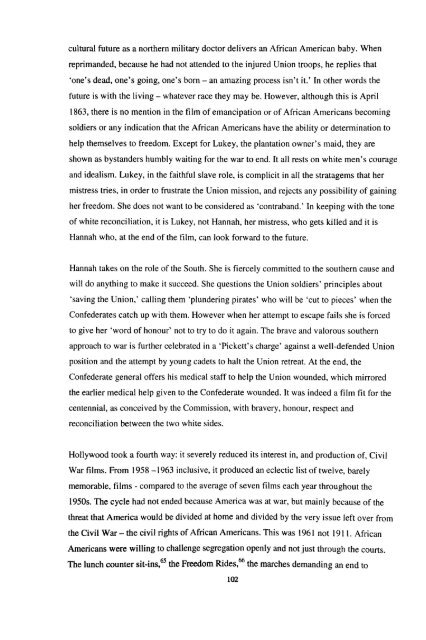Download (3483kB) - Greenwich Academic Literature Archive ...
Download (3483kB) - Greenwich Academic Literature Archive ...
Download (3483kB) - Greenwich Academic Literature Archive ...
- No tags were found...
You also want an ePaper? Increase the reach of your titles
YUMPU automatically turns print PDFs into web optimized ePapers that Google loves.
cultural future as a northern military doctor delivers an African American baby. Whenreprimanded, because he had not attended to the injured Union troops, he replies that'one's dead, one's going, one's born - an amazing process isn't it.' In other words thefuture is with the living - whatever race they may be. However, although this is April1863, there is no mention in the film of emancipation or of African Americans becomingsoldiers or any indication that the African Americans have the ability or determination tohelp themselves to freedom. Except for Lukey, the plantation owner's maid, they areshown as bystanders humbly waiting for the war to end. It all rests on white men's courageand idealism. Lukey, in the faithful slave role, is complicit in all the stratagems that hermistress tries, in order to frustrate the Union mission, and rejects any possibility of gainingher freedom. She does not want to be considered as 'contraband.' In keeping with the toneof white reconciliation, it is Lukey, not Hannah, her mistress, who gets killed and it isHannah who, at the end of the film, can look forward to the future.Hannah takes on the role of the South. She is fiercely committed to the southern cause andwill do anything to make it succeed. She questions the Union soldiers' principles about'saving the Union,' calling them 'plundering pirates' who will be 'cut to pieces' when theConfederates catch up with them. However when her attempt to escape fails she is forcedto give her 'word of honour' not to try to do it again. The brave and valorous southernapproach to war is further celebrated in a 'Pickett's charge' against a well-defended Unionposition and the attempt by young cadets to halt the Union retreat. At the end, theConfederate general offers his medical staff to help the Union wounded, which mirroredthe earlier medical help given to the Confederate wounded. It was indeed a film fit for thecentennial, as conceived by the Commission, with bravery, honour, respect andreconciliation between the two white sides.Hollywood took a fourth way: it severely reduced its interest in, and production of, CivilWar films. From 1958 -1963 inclusive, it produced an eclectic list of twelve, barelymemorable, films - compared to the average of seven films each year throughout the1950s. The cycle had not ended because America was at war, but mainly because of thethreat that America would be divided at home and divided by the very issue left over fromthe Civil War- the civil rights of African Americans. This was 1961 not 1911. AfricanAmericans were willing to challenge segregation openly and not just through the courts.The lunch counter sit-ins,65 the Freedom Rides,66 the marches demanding an end to102
















